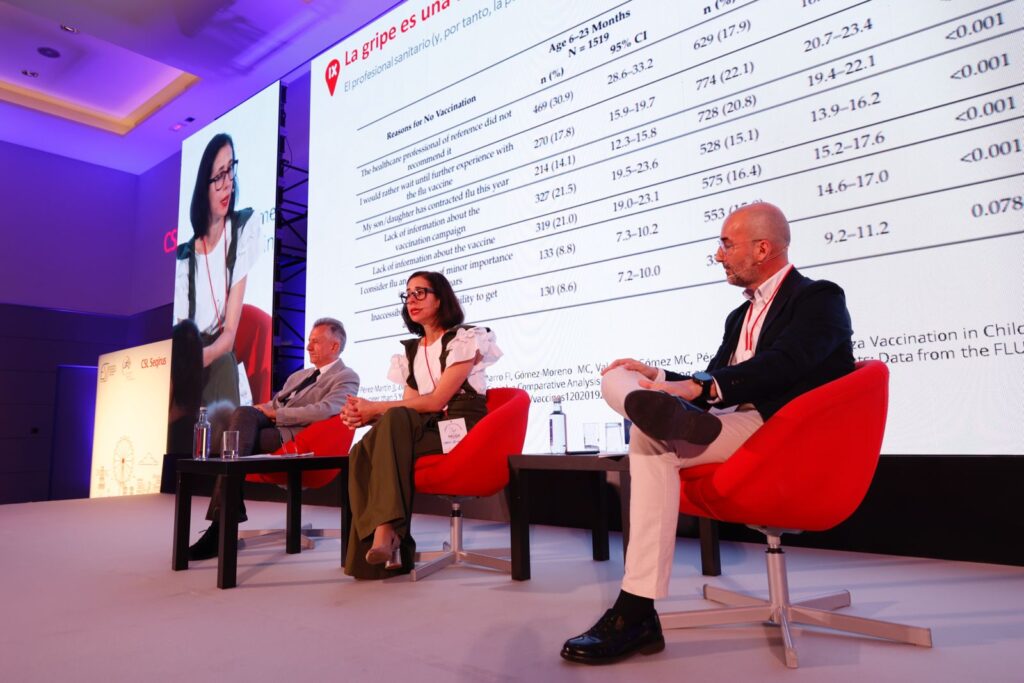Currently, strengthening influenza vaccination is one of the “mother goals” set by experts to contribute to improving public health and preventing influenza.In fact, the ultimate goal is Seasonal influenza incidence in 2023-2024 similar to pre-pandemic years. To achieve this goal, vaccination campaigns are key allies in prevention strategies.To this end, CSL Seqirus organizes Ninth Influenza Update MeetingThe conference aims to promote science dissemination and facilitate dialogue among all actors in the sector to improve public health, prevent and enhance progress in influenza vaccination.
Prevention during pregnancy
At the founding meeting, José Antonio Navarro, Permanent Honorary Advisor, Ministry of Health, an in-depth study of the prevention of viral infections and other respiratory pathogens during pregnancy.More specifically, it addresses vaccine-preventable respiratory infections such as Influenza, COVID-19, and respiratory syncytial virus (RSV)).

Regarding the flu vaccine, he said that in healthy pregnant women, the disease can cause Two to five times increased risk of severe respiratory illness (especially in the first and second trimester) Get a primary care consultation. In terms of hospitalizations, hospitalization rates are higher in the third trimester.
During his speech, he also visited How effective is this vaccine? Both in pregnant women and fetuses and infants. “In 2022, the influenza vaccine coverage in this population in Spain will be 53.59% and the health care coverage will be 48.45%,” he stressed. Therefore, he stressed the importance of increasing these in both groups.
In conclusion, Navarro believes that there are multiple causative agents with varying severity of symptoms; COVID-19 and influenza viruses are serious and preventable through immunization; effective protection must be provided to pregnant women, fetuses, and newborns, and could improve coverage for both diseases.
Promote the correct use of vaccines
Next, Miguel Ángel Calleja, Pharmacy Service, Virgen Macarena University Hospital, Sevilleand Antonio J. García, Professor of Health Economics and Health Outcomes, Department of Pharmacology and Clinical Therapeutics, School of Medicine, University of Malagastressed the importance of promoting the correct use of vaccines.
“Coverage can be improved and it looks like we are dropping back to pre-pandemic percentages”
Miguel Angel Callejafrom the Pharmacy Service, Virgen Macarena University Hospital, Seville.
On the one hand, Calleja delves into Efficiency and cost-effectiveness of vaccination and tools to promote access to vaccines. “Seventy percent of pharmaceutical investments are aimed at solving preventable health problems,” he stressed. In addition, he specifically emphasized that although the efficiency and effectiveness percentage of vaccines have greatly improved in recent years, “coverage can still be improved, but it seems to be declining to pre-pandemic percentages.” warn.
Likewise, he stressed that when it comes to vaccines, “we don’t have to talk about spending, we have to talk about investment.” Calleja also highlighted payment-for-value or payment-for-results agreements as tools with potential in influenza vaccination. “This will allow us to reach more patients,” he said.

Next, Garcia revealed that by 2023, the average cost of vaccination for a person in Spain will be 1,520 euros. “The issue is The cost in 2023 will increase by 124.8% compared with 2019“, COVID-19 vaccines are not included,” he stressed. Furthermore, he assured that “the economy has never been more dependent on health, and future health will depend on the economy.”
The average cost of vaccination in Spain in 2023 will be €1,520 per person
Along these lines, he insists, recent research highlights economic fog and the failure of political leaders to take all factors into account. Benefits of vaccination program.“This shortcoming demonstrates that these programs are grossly undervalued, and that many decisions regarding the adoption, scale-up and investment in vaccine discovery and development are not fully informed,” he claimed. In fact, he noted that “Effective Vaccination Improving health equity and health systems. There is a need to provide a new approach based more on the social value it generates rather than the economic costs it imposes,” he concluded.
Influenza, a pediatric disease

The second panel of the day discussed the need for pediatric vaccination, an issue addressed from a healthcare and public health perspective. Ignacio Salamanca, from the IHP Group Research and Research Areas, and Matilde Zornoza, from the Health Prevention and Protection Services, General Directorate of Public Health and Addictions of the Region of Murciais responsible for clarifying the situation in this regard.
“Flu is a pediatric disease”, this is the main message that the two speakers want to convey to the attendees. Today, patients and health professionals associate the flu with older adults, but it is a pediatric disease, Salamanca said. “It’s taken us a long time to get childhood vaccinations even though we have the highest rates of this respiratory infection,” he lamented.
In this regard, he emphasized that this pathology imposes a large care burden in primary care (PC), but it can also produce important hospital complications.To this end, he advocates that we should not ignore Vaccination of pregnant women as primary prevention strategy for the pediatric population.
An average of 8 children die from influenza in Spain each season
Zornosa came up with a figure that left everyone present unmoved: In Spain, an average of eight children die from the disease every season. Along these lines, Salamanca insists that there is currently a great deal of concern about the complications caused by this disease, “half of all cases of otitis media are caused by or related to influenza infection. These must be taken into account when classifying the disease” factors.” In fact, Salamanca wants to emphasize, “We must not forget that the flu can be fatal, a message that parents and health care providers are not aware of.” “The main problem is that health care providers are not Thinking that pediatric patients have the flu is a problem,” Zornoza added.
“Flu can be deadly, and parents and health care providers don’t understand that.”“
Ignacio Salamancafrom IHP Group Research and Research Areas.
The two speakers also focused on the discussion AP Influenza Diagnosis. Salamanca emphasized that diagnostic testing “is one of the reasons why influenza is not visible. The person recommended to be vaccinated is a pediatrician or a pediatric nurse, but the diagnosis is made in the hospital,” he said. Therefore, he emphasized the importance of providing influenza diagnostic testing in AP.
Family doctors will offer rapid multi-viral diagnostic tests
Actually, Jose de la FlorMembers of the Spanish Society of Extra-hospital Paediatrics and Primary Care (SEPEAP) Vaccines and Infectious Diseases Working Group, which chairs the table, said there is a ministerial order requiring this information to be made available throughout Spain. National Health System (SNS). ). “In a very short time, multi-virus rapid diagnostic tests will be available at PC clinics,” he assured.
Vaccination in education centers is an effective strategy

One of the challenges facing childhood vaccination is the lack of a unified implementation strategy across the country.Two speakers reviewed the situation and implications Vaccination campaign 2022-2023 In the Autonomous Regions of Murcia and Andalusia. In this regard, Zornoza used the first case as an example to explain through data the potential of vaccination in education centers and how this strategy can have a positive impact by increasing vaccination coverage among the child population.
Concluding his intervention, Salamanca insisted on the need to incorporate Galicia’s hospital vaccination model and Murcia’s school vaccination model. “Influenza vaccination campaigns must be intensified; bets on vocational training; awareness-raising; increased access to vaccination; public health and scientific communities aligned and vaccination and effectiveness results updated,” he concluded.

